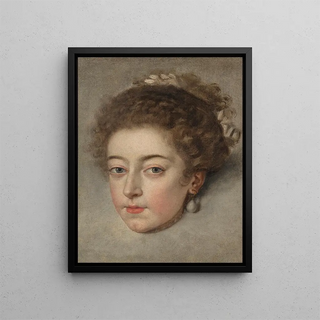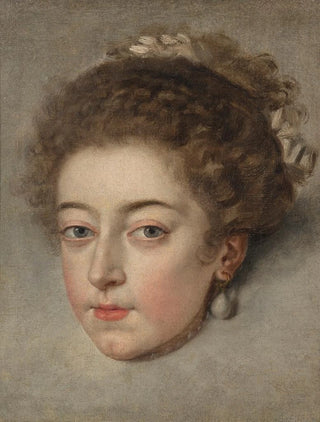Art print | Study of the head of Queen Henrietta Maria of France - Frans Pourbus the Younger


View from behind

Frame (optional)
The artwork "Study of the head of Queen Henriette-Marie of France" by Frans Pourbus the Younger embodies the quintessence of 17th-century portrait painting. This masterpiece, with its delicacy and refinement, immerses us in the royal universe of old France, where every brushstroke tells a story. Queen Henriette-Marie, wife of Charles I of England, is depicted here with an intensity that transcends a simple portrait. The penetrating gaze and subtle expression of her face invite the viewer to a deep contemplation, revealing the complexities of her personality and life.
Style and uniqueness of the artwork
The piece stands out for its baroque style, characterized by meticulous attention to detail and skillful use of light. Frans Pourbus the Younger, master of portraiture, succeeds in capturing not only the physical appearance of the queen but also her spiritual essence. The delicate nuances of the skin, the shimmering reflections of luxurious fabrics, and the finesse of the accessories testify to exceptional craftsmanship. Every element, from the sparkling jewelry to the texture of the hair, is carefully rendered, creating a visual harmony that delights the eye. This portrait is not merely a representation; it is a celebration of beauty and power, a tribute to the dignity of a queen whose legacy endures through the centuries.
The artist and his influence
Frans Pourbus the Younger, born in 1569 in Antwerp, is one of the most influential portraitists of his time. Son of Frans Pourbus the Elder, he inherits remarkable talent and a reputation that precedes him. His career leads him to the court of France, where he becomes the official painter for several members of royalty. His style, infused with Flemish and Italian influences, allows him to stand out and leave a lasting mark on the art of portraiture. Through his works, he manages to establish a dialogue between the subject and the viewer, a characteristic that will continue to inspire artists of subsequent generations. The portrait of Queen Henriette-Marie is emblematic.

Matte finish

View from behind

Frame (optional)
The artwork "Study of the head of Queen Henriette-Marie of France" by Frans Pourbus the Younger embodies the quintessence of 17th-century portrait painting. This masterpiece, with its delicacy and refinement, immerses us in the royal universe of old France, where every brushstroke tells a story. Queen Henriette-Marie, wife of Charles I of England, is depicted here with an intensity that transcends a simple portrait. The penetrating gaze and subtle expression of her face invite the viewer to a deep contemplation, revealing the complexities of her personality and life.
Style and uniqueness of the artwork
The piece stands out for its baroque style, characterized by meticulous attention to detail and skillful use of light. Frans Pourbus the Younger, master of portraiture, succeeds in capturing not only the physical appearance of the queen but also her spiritual essence. The delicate nuances of the skin, the shimmering reflections of luxurious fabrics, and the finesse of the accessories testify to exceptional craftsmanship. Every element, from the sparkling jewelry to the texture of the hair, is carefully rendered, creating a visual harmony that delights the eye. This portrait is not merely a representation; it is a celebration of beauty and power, a tribute to the dignity of a queen whose legacy endures through the centuries.
The artist and his influence
Frans Pourbus the Younger, born in 1569 in Antwerp, is one of the most influential portraitists of his time. Son of Frans Pourbus the Elder, he inherits remarkable talent and a reputation that precedes him. His career leads him to the court of France, where he becomes the official painter for several members of royalty. His style, infused with Flemish and Italian influences, allows him to stand out and leave a lasting mark on the art of portraiture. Through his works, he manages to establish a dialogue between the subject and the viewer, a characteristic that will continue to inspire artists of subsequent generations. The portrait of Queen Henriette-Marie is emblematic.






